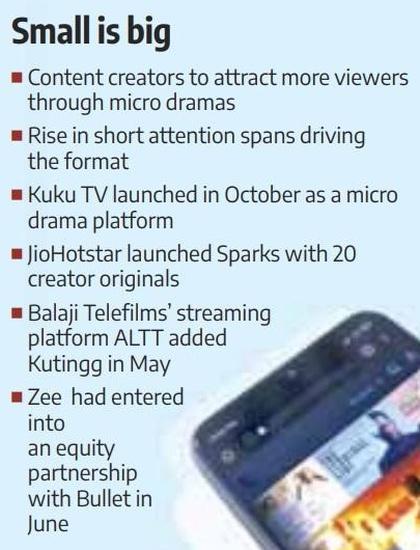Micro dramas — typically 30 seconds to one to two minutes long per episode — are designed for mobile-first audiences.

Kindly note the image have only been published for representational purposes. Photograph: Kind courtesy Yousaf Bhutta/Pixabay
Streaming platforms are creating separate subsections to offer micro dramas and are also exploring content made by influencers and creators to attract more viewers, compete with social media platforms, and expand their monetisation streams.
This comes at a time when the industry is witnessing a rise in mobile-first audiences, largely driven by short-format content.
In May, Balaji Telefilms’ streaming platform ALTT added Kutingg, while Zee Entertainment Enterprises in June announced a strategic equity partnership with Bullet, a new-age content and technology startup, to offer micro dramas to its audiences.
In October, Kuku TV was launched as a micro-drama platform by Kuku FM. Regionally, JOJO — a Gujarati-language entertainment platform — is also planning to enter the micro-drama space.
Earlier, Zee had said in a statement that as the digital ecosystem grows exponentially, it is constantly identifying value-accretive opportunities to drive scale.
Its strategic partnership with Bullet aims to build a competitive advantage by identifying innovative formats and scaling them across platforms to drive monetisation.
Like ALTT, the company will integrate the micro-drama segment into its ZEE5 ecosystem.
Micro dramas — typically 30 seconds to one to two minutes long per episode — are designed for mobile-first audiences, also known as the vertical video content segment.
A media executive said that as mobile content consumption rises, the vertical video format offers fast narrative storytelling in a scrolling style, similar to Instagram Reels.
Shorter attention spans and a shift from big to small screens have helped fuel the growth of this segment in India, said a spokesperson from a micro-drama platform.
“Micro-dramas fit into everyday life without demanding too much time — and that’s what’s working,” said Dhruvin Shah, founder and CEO, JOJO.
“The vertical format, especially with mobile-first platforms, just makes it super accessible. At JOJO, we saw this trend building. That’s why we’re working on something called JO, our micro-drama vertical, which is still under development. We’re building JO to showcase original Gujarati micro-fiction, creator content, and even artificial intelligence-led storytelling.”
On the platform, Shah added long-form content averaged 45 to 60 minutes of daily watch time.
However, when they experimented with vertical, short-form pilots, the average daily watch time jumped to over 90 minutes in some cases. “That kind of engagement is a big win for advertisers,” Shah said.

For Kuku TV, 80 per cent of its audience is from Tier-I and Tier-II cities. While the company’s spokesperson did not share the exact subscriber base, they said the platform’s subscriber growth has been strong since launch.
Currently, Kuku TV has 50 million downloads on the Play Store and has ranked as the No. 1 app by downloads for several weeks.
It is now among the top micro-drama apps globally, according to the spokesperson.
“Viewers are already accustomed to shorter-format user-generated content via Reels and Shorts. Professionally generated content, offering more serialised storytelling in a convenient format, has led users to flock to micro dramas in genres they’re familiar with or enjoy,” the spokesperson said.
Like micro dramas, the creator-led content segment — usually featuring influencers and creator-led shows — is also growing.
In February, JioHotstar launched Sparks, an initiative with 20 exclusive originals across 10 genres.
In May, Dish TV’s over-the-top (OTT) aggregator platform Watcho launched a new segment called FLIQS, an open platform for professionally generated content by filmmakers and creators.
While creators can set up their own channels similar to YouTube, Watcho, through FLIQS, helps generate traffic, promote their work, and allows creators to choose how to monetise their content — through models like transactional video-on-demand (TVOD) and subscription video-on-demand (SVOD).
“Since we’re an aggregator, whether it’s micro content, micro dramas, or any other trend — if it’s offered by a partner OTT platform, it automatically becomes part of Watcho. And if a creator wants to upload micro dramas directly, they can do that via FLIQS,” said Sukhpreet Singh, chief revenue officer, Dish TV.
A media analyst, who spoke on condition of anonymity, said that with a wealth of free content available on TV, social media, and YouTube, OTT platforms in India need to keep evolving to stay on par with existing platforms that already capture audience attention.
“With at least ₹1,000 crore needed to sustain OTT platforms in India, they will continue to evolve and explore multiple monetisation streams like TVOD, SVOD, and advertising VOD,” the analyst said.
Feature Presentation: Rajesh Alva/Rediff




